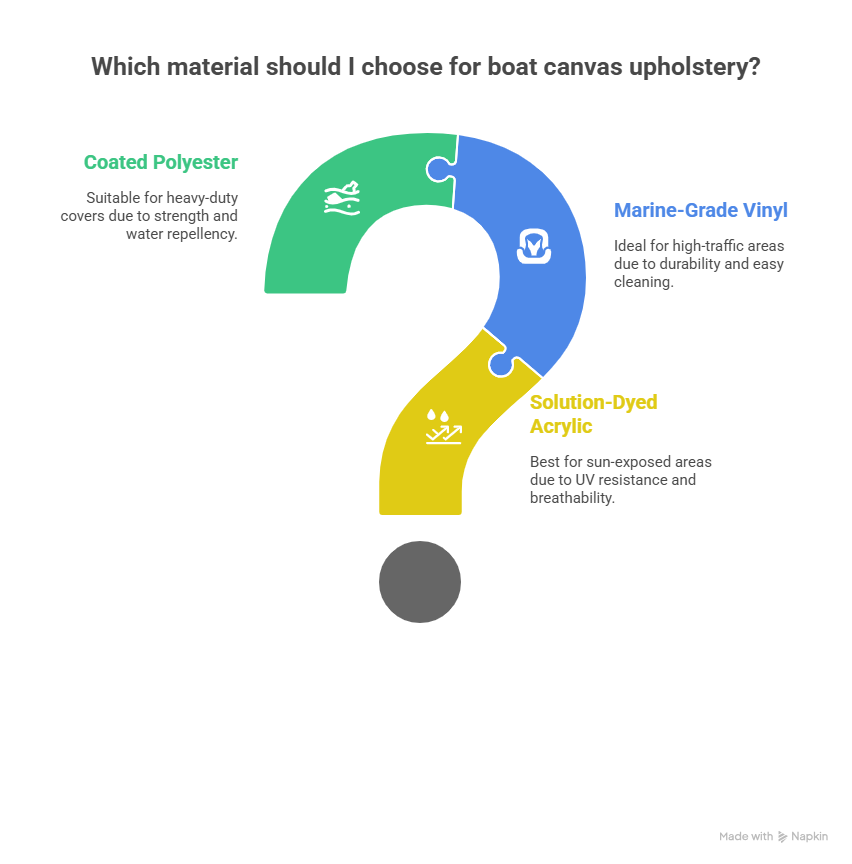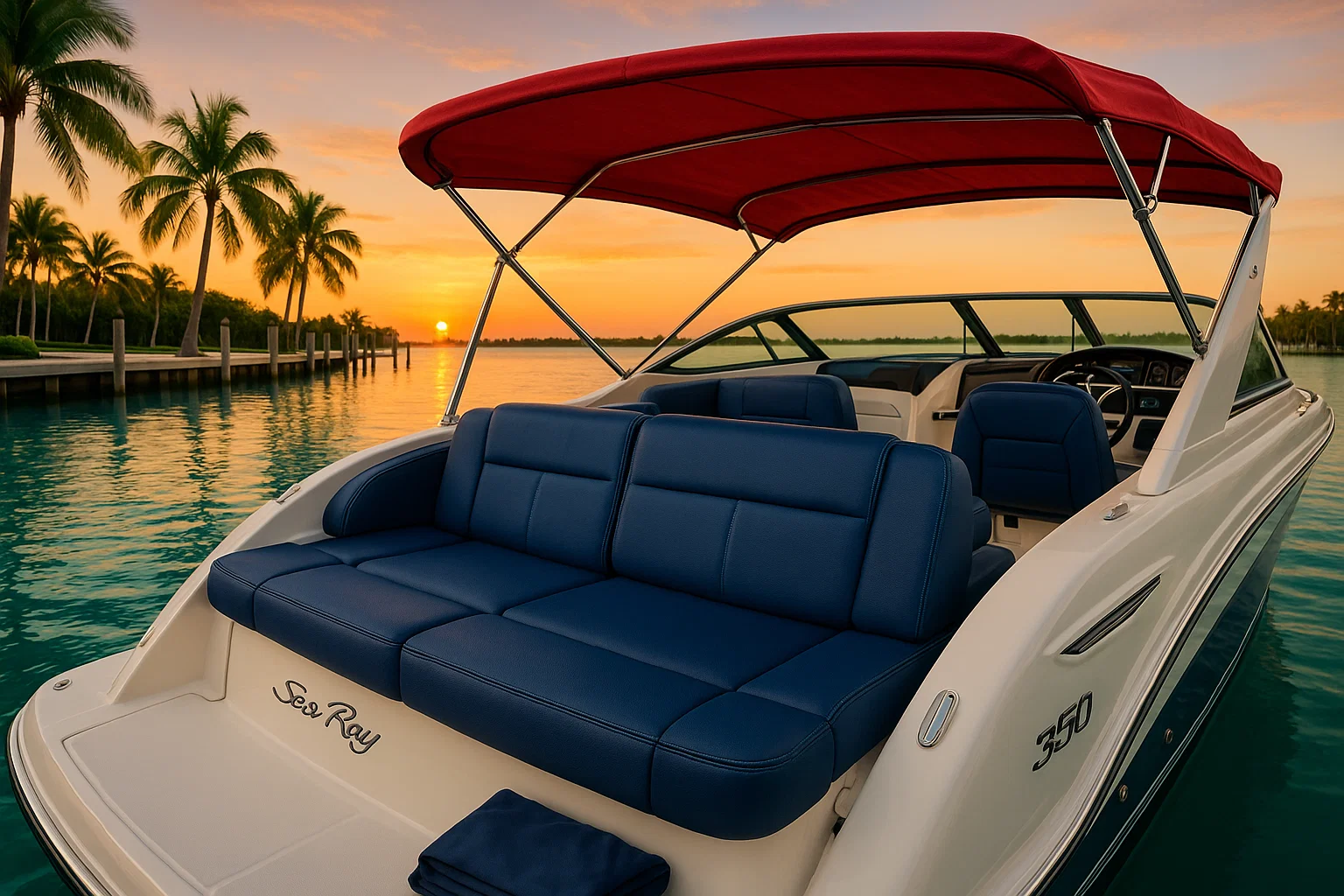Boat Canvas Upholstery: 15 Years of Crafting Durable Comfort
I’ve been stitching boat canvas upholstery in South Florida for 15 years, from Miami’s bustling marinas to Fort Lauderdale’s quiet docks. Last June, a client named Javier hauled his 2021 Sea Ray 350 into Dinner Key Marina, frustrated because his cockpit cushions were cracked and mildewed after just one season. I took one look and knew the problem: cheap vinyl and cotton thread that couldn’t handle the sun and salt. A $1,200 job later, his boat looked sharp again. Boat canvas upholstery isn’t just about looks—it’s a system built to survive the marine environment. Here’s what I’ve learned to help you choose, install, and maintain boat canvas upholstery that lasts.
Table of Contents
What Makes Boat Canvas Upholstery Different?
The marine environment is a beast—sun, salt, and humidity chew through regular fabric like nothing. Boat canvas upholstery isn’t just any fabric; it’s a complete system designed to fight UV rays, moisture, and wear. I learned this the hard way in 2010 when I used household polyester for a buddy’s Boston Whaler. It faded in months. Now, I only use marine-grade materials, and here’s why they matter.
Marine-grade means every component—fabric, thread, foam, fasteners—is engineered for the sea. Last summer, a client at Stiltsville had rust stains all over her new cushions because the shop used standard staples. Cost her $800 to redo. A good boat canvas upholstery job uses stainless steel hardware and PTFE thread to avoid that mess. It’s about building something that’ll outlast Florida’s brutal summers.
Why Does Marine Upholstery Fail So Fast?
Marine upholstery faces a gauntlet: UV radiation breaks down fibers, saltwater corrodes hardware, and humidity breeds mildew. I’ve seen brand-new boats at Bahia Mar with faded Bimini tops because the fabric wasn’t solution-dyed. Boat canvas upholstery has to be purpose-built, or it’s toast in a season.
Take Maria’s Grady-White 208 last July. Her helm chair vinyl cracked after a year—cheap material, no UV coating. I replaced it with Sunbrella Horizon vinyl, and it’s still holding up. The right boat canvas upholstery choice makes all the difference, whether it’s for seats, covers, or sun pads.
What’s the Best Material for Boat Canvas Upholstery?
Choosing boat canvas upholstery means matching the material to the job. I’ve worked with three main fabrics over the years, each with its strengths. Here’s how they stack up.
Solution-Dyed Acrylics: Fade-Proof Comfort
Solution-dyed acrylics, like Sunbrella, are my go-to for sun-exposed areas. The color’s locked into the fiber during manufacturing, so it doesn’t fade. I used Sunbrella for a client’s T-top in Key Biscayne last spring—still vibrant after a year of Miami sun.
- Pros: Unmatched UV resistance, breathable to prevent mildew, soft feel.
- Cons: Higher cost, needs regular cleaning to avoid stains.
- Best For: Bimini tops, sun pads, interior cushions.
Marine-Grade Vinyl: Tough and Wipe-Clean
Marine vinyl, like Nautolex, is a workhorse for high-traffic areas. Its waterproof topcoat shrugs off spills and salt. I fixed a cockpit bench for a guy at Coconut Grove with Sunbrella Horizon—$600 and it’s still spotless.
- Pros: Durable, waterproof, easy to clean.
- Cons: Less breathable, can feel hot in direct sun.
- Best For: Helm chairs, cockpit seating.
Coated Polyester: Rugged Protection
Coated polyester, like Top Gun, is built for heavy-duty covers. It’s tear-resistant and water-repellent. I used it for a mooring cover on a client’s Bayliner 285 last month—$400 and it’s held up through storms.
- Pros: Strong, abrasion-resistant, cost-effective.
- Cons: Stiffer feel, less breathable.
- Best For: Mooring covers, enclosures.

How Do I Choose the Right Boat Canvas Upholstery?
Picking boat canvas upholstery is about function, not just looks. I tell clients to think about the job: sun protection, seating, or storage? Here’s my guide based on 200+ upholstery jobs.
- Cockpit Seating: Go with marine vinyl for durability and easy cleaning. I swapped out a worn set on a Sea Ray 230 last summer—$500 and the owner’s thrilled.
- Bimini Tops: Use solution-dyed acrylic for fade resistance and breathability. Sunbrella’s my pick after seeing cheaper fabrics fade fast.
- Mooring Covers: Coated polyester’s rugged enough for constant exposure. It saved a client’s electronics during a Key Biscayne storm.
- Interior Cushions: Acrylics with OEKO-TEX certification feel cozy and hold up indoors.
Table: Boat Canvas Upholstery Options
I put this table together from jobs I’ve done in South Florida:
| Material | Best Use | UV Resistance | Breathability | Cost |
|---|---|---|---|---|
| Solution-Dyed Acrylic | Bimini tops, sun pads | Excellent | Excellent | $50–$100/yd |
| Marine-Grade Vinyl | Cockpit seats, helm chairs | Very Good | Low | $30–$80/yd |
| Coated Polyester | Mooring covers, enclosures | Good | Low | $20–$50/yd |
What Components Make a Quality Boat Canvas Upholstery Job?
The fabric’s only half the story. A bad thread or rusty snap can ruin great boat canvas upholstery. I learned this in 2012 when a client’s cushions split at the seams—cotton thread rotted in six months.
- Thread: Use UV-treated polyester or PTFE (Teflon) thread. PTFE’s my choice—it’s got a lifetime guarantee and won’t rot. Cost me $100 extra for a job last year, but it’s worth it.
- Hardware: Stainless steel snaps and Vislon zippers prevent rust. I saw a boat at Fort Lauderdale with corroded staples—$200 in damage.
- Foam: Open-cell foam drains water for deck cushions; closed-cell is firmer but waterproof. I use open-cell for most jobs to avoid soggy seats.
Ask your fabricator about these. Their answer tells you if they’re cutting corners.
How Do I Maintain Boat Canvas Upholstery?
Maintenance is the secret to making boat canvas upholstery last. I’ve seen $2,000 jobs ruined by neglect. Here’s my routine from years at Miami marinas.
- Acrylics: Brush off dirt, scrub with mild soap and water, rinse well, and air dry completely. I cleaned a Sunbrella Bimini top last week—10 minutes and it looked new.
- Vinyl: Wipe with a soft cloth and soap solution. Avoid harsh cleaners; they strip topcoats. I saved a client’s vinyl seats from pinking with a $15 mildew remover.
- Storage: Never store damp cushions. I dry everything thoroughly before covering—learned that after mildew wrecked a client’s cushions in 2018.
Use a fabric guard spray every few seasons to restore water repellency. It’s a $20 fix that saves hundreds.
What Are Common Boat Canvas Upholstery Mistakes?
I’ve seen plenty of mistakes wreck boat canvas upholstery. Last month, a guy at Bahia Mar used household cleaner on his vinyl—stripped the coating, $600 to replace. Stick to marine-grade materials and proper care, and you’ll avoid most headaches.
FAQ: Boat Canvas Upholstery Questions Answered
How Often Should I Replace Boat Canvas Upholstery?
I check my boat’s upholstery every season. Well-maintained marine vinyl or acrylic can last 5–10 years. Last July, I replaced a client’s 7-year-old Sunbrella top for $800—it was still in decent shape but starting to fade. Regular cleaning extends life.
What’s the Best Fabric for Boat Canvas Upholstery?
It depends on the job. I use Sunbrella acrylic for Bimini tops because it’s fade-resistant and breathable. For seats, marine vinyl like Nautolex is tough and easy to clean. I fixed a Sea Ray’s cockpit with vinyl for $600—still looks great.
How Do I Clean Boat Canvas Upholstery?
For acrylics, I brush off dirt and scrub with soap and water, rinsing thoroughly. Vinyl just needs a wipe with a soft cloth and mild soap. Last week, I cleaned a client’s cushions in 15 minutes. Always air dry to prevent mildew.
Can I Use Household Fabric for Boat Canvas Upholstery?
No way. Household fabric fades and rots fast in saltwater. I tried it once in 2010—total disaster. Stick to marine-grade materials like Sunbrella or Top Gun for durability.
How Do I Prevent Mildew on Boat Canvas Upholstery?
Keep it clean and dry. I use breathable acrylics for tops and dry cushions thoroughly before storage. A $20 fabric guard spray every few seasons helps. Mildew ruined a client’s cushions once—$500 lesson.
What’s the Cost of Boat Canvas Upholstery?
It varies. A Bimini top might run $500–$1,500, seats $300–$800 per piece. I did a full cockpit reupholstery for $2,000 last summer. Quality materials and labor aren’t cheap but save money long-term.
How Do I Choose a Fabricator for Boat Canvas Upholstery?
Ask about thread, hardware, and foam. I walked away from a shop that used cotton thread—big red flag. Check reviews at marinas like Bahia Mar and ensure they use marine-grade materials.
Conclusion
Boat canvas upholstery is more than a style choice—it’s a system built to protect your boat and keep you comfortable. I’ve seen too many owners, like Javier at Dinner Key, waste money on cheap materials that fail fast. Choose solution-dyed acrylic for sun protection, marine vinyl for seats, and coated polyester for covers. Scrutinize thread and hardware—PTFE and stainless steel are non-negotiable. A little cleaning goes a long way. Walk your boat today, check your upholstery, and ask fabricators the tough questions. Quality boat canvas upholstery means more time on the water and less time fixing mistakes.
Author Bio
I’m Alex, a marine fabricator with 15 years of experience crafting boat canvas upholstery in South Florida. I’ve reupholstered 200+ boats, from Sea Rays to Bayliners, at marinas like Dinner Key and Bahia Mar. Certified by the Marine Fabricators Association, I use only marine-grade materials like Sunbrella and PTFE thread.

